How to make a phenomenal pho at home
You don’t need to go to Hanoi to make first class pho (although it couldn’t hurt, you should book that holiday). Here’s the key to creating a full-flavoured pho in your own kitchen.
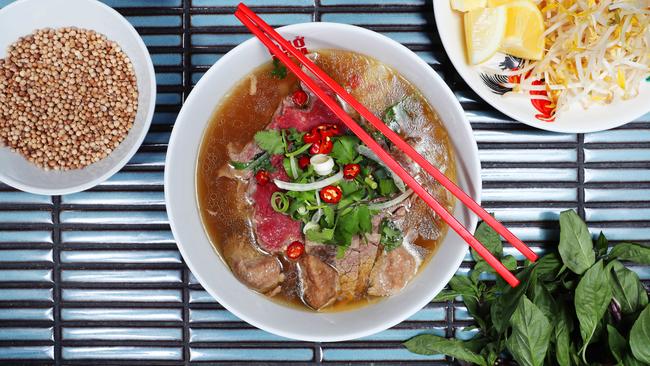
Eating Out
Don't miss out on the headlines from Eating Out. Followed categories will be added to My News.
On one hand it’s a simple noodle soup of meaty broth enlivened with spice and herbs.
On the other, it’s a national dish of infinite variations and complex depth that’s arguably Vietnam’s most successful export.
It’s as popular in Melbourne for lunch as it is in Hanoi, where it’s been eaten for breakfast for more than 100 years.
Pronounced “fuh”, pho first appeared around the time of French colonisation in Northern Vietnam and is said to have evolved from the French beef stew — pot au feu — that was introduced at that time.
Before the French arrived, cows were used in Vietnam for labour, not primarily as food, but this changed with the introduction of the French beef stew that uses the cartilaginous and marrow-rich beef bones for its broth, which is also the basis of pho.
Pho differs not only from region to region but household to household, but broadly speaking the pho of the north — pho bac — is prized for its delicate and clear broth whereas pho nam, the pho of the south, has a richer, more deeply spiced broth which is garnished with bean shoots, herbs and chilli.
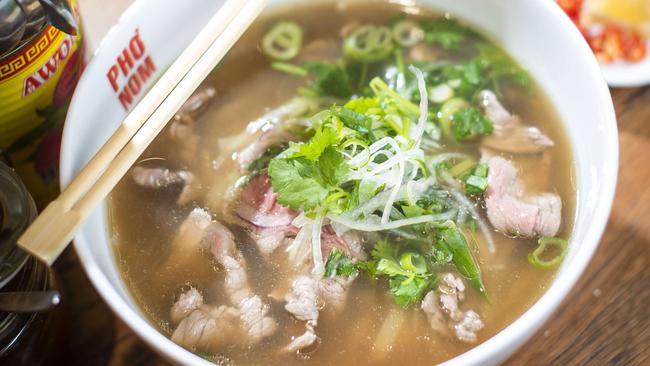
Jerry Mai says no matter where you’re from, pho is a family affair.
“Most Vietnamese mothers make it all the time. It’s not about making pho in a tiny little pot for yourself, in a quick little cheat broth. Mum cooks it for two days, she cooks it today to eat tomorrow, then all the cousins, aunties, uncles, and friends if they are lucky enough to get an invitation, come over to help you eat it.”
The chef behind the Pho Nom soup shops in the CBD says pho has become an integral part of the modern Melbourne food scene.
“I love how pho has moved on from 10-15 years ago, you only had pho if lived near Springvale or Richmond or had Asian friends who took you there, or invited you to their house when their mum was making it. Nowadays everyone has an opinion on pho. We all have a different way we like it,” she says.
“That we’re talking about pho with such passion and conviction, it’s really exciting.”
But what makes great pho?
“It’s all down to family, everyone has a family recipe — and their recipe is the best recipe and you don’t argue with it,” Jerry jokes.
“The pho I serve at Pho Nom is a recipe passed down from my mother. The stock relies on good-quality beef bones and is reduced over a long period to develop maximum flavour.”
While going out for a bowl of pho makes for a quick, easy and nutritious lunch or dinner, Jerry says making pho at home is simple — all you need is time. And a very big pot.
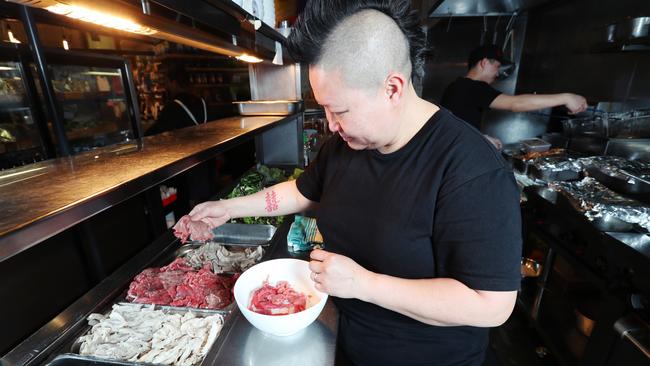
STOCK TIPS
The key to a full flavoured pho is the bone broth, which Jerry says should be made from beef marrow bones — shin and knuckle bones — and not others, such as neck or rib bones, which affect the clarity of the broth during cooking. The marrow gives the broth a glistening sheen of fat, which is called the “golden layer”.
“You’re looking for this beautiful golden layer on top of the broth in your final bowl of pho,” Jerry says.
REDUCTION SEDUCTION
Wash the bones to remove any blood or splinters then place in a large stockpot — at least 10L — and cover with cold water. Bring to the boil and blanch bones for 30 mins, removing any impurities floating on the surface. Drain and return bones to the clean pot, cover with freshwater and leave to simmer for several hours.
“You want the stock to reduce by about 30 per cent. The preparation is the main thing, the rest of it is sitting back relaxing and letting this broth fill your home with its beautiful aromas.”
FLAVOUR SAVOURS
Grilling the aromats for the pho — garlic, onions and ginger — over a flame or under the grill until they are caramelised will add sweetness to the broth, while cooking the beef brisket will add meaty depth to it.
“We add in some wagyu tails as well, for extra flavour and extra beefiness and fat — that’s really important to us,” Jerry says.
The brisket will take about 3-4 hours to cook. Remove, cool and save for serving. The oxtail can stay in the broth throughout the cooking process.
In the last 90 minutes, toast the spices — star anise, cardamom, cassia, cloves and coriander seeds — and place into a muslin bag (or clean Chux cloth) secure and float in the broth.
“I don’t like leaving the spices in there too long as it can make the broth go too dark, and it can make the broth a bit bitter,” Jerry says.
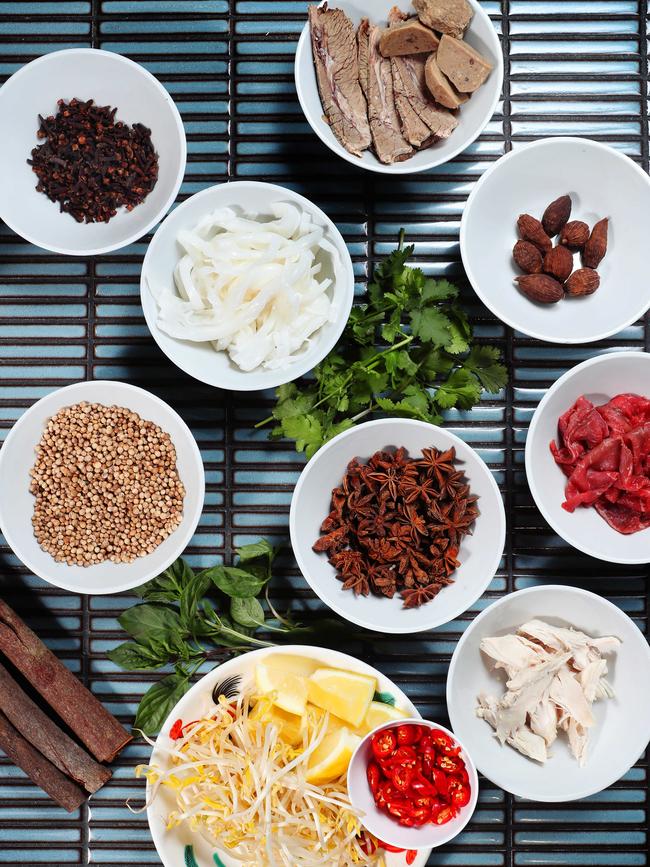
OODLES OF NOODLES
“When my parents arrived in Australia there were no fresh noodles, so we used dried packet noodles, which are very similar to the noodles they use for pad thai. You soak them, blanch them, use that for pho noodles,” Jerry says.
“Nowadays we have the luxury of fresh noodles, beautiful fresh silky soft pho noodles. Most Asian supermarkets stock them.”
Jerry says these fresh noodles should not be stored in the fridge, as the glutinous rice starch hardens and will turn the noodles into a thick block. Simply leave on the kitchen bench until ready to use — they will last for two to three days.
To cook the fresh noodles, using a small noodle basket (also available at Asian supermarkets) dunk into boiling water for just a few seconds to warm through. “If you cook for longer than 30 seconds they will start to fall apart. Remember, once the broth hits them they will become super soft and silky,” Jerry says.
SEASON TO TASTE
Jerry says like the broth, the condiments used to garnish pho differ from north to south.
“In the north they use pickled onion, pickled garlic, pickled ginger with some fish sauce and pepper, whereas in the south it’s more flamboyant — we add everything,” she says.
It’s the southern pho garnished with Thai basil, bean shoots and chilli that most people will be familiar with, with hoisin sauce and chilli sauce — often sriracha — and fresh lemon on the table to add to taste.
“In parts of Saigon they serve it with big saw tooth coriander. I’ve seen rice paddy herbs being used — even mint in some venues. Central Vietnam is a bit different as well, more chilli oil and lemongrass, and their garnish is more a salad — lettuce and some herbs. It changes through the country, but the base, the core of it is the broth.”
Jerry says there’s no wrong way of eating pho, no one way of eating it.
“Everyone seasons differently — that’s the fun bit. No bowl of pho should be the same — we say pimp up you pho as much as you like,” Jerry says.
HOT STUFF
“It’s important to have the broth super-hot before adding to noodles, as you have meat to cook, the noodles, plus if you’re adding bean shoots, sliced onion in there, that will drop the temperature as well,” Jerry says.
Rather than add all the condiments at once, Jerry suggests adding a little at a time. “Add some bean shoots, basil and eat it, before adding more. Think about a little Thai basil leaf stewing in hot stock for five minutes — it turns brown and not aromatic at all.”
BIG DIPPER
It’s not just seasoning the bowl of pho that adds a level of customisation to pho, but a dipping sauce on the side for the slices of meat.
“People usually take the meat and eat it straight up, but you should take a small bowl of dipping sauce for the meat, whether fish sauce and chillies, or a mix of hoisin, chilli and fish sauces with some lemon juice, that I like,” Jerry says.
“The dipping sauce is really good fun, dip the meat in, you have the noodles, the soup. There’s so much going on, every mouthful there’s something else.”
CHICKEN LICKEN
“The most underrated is a chicken pho, I forget how much depth and flavour there is in a chicken pho. It’s a bit more delicate, as well,” Jerry says.
The process for making chicken pho — pho ga — is similar to that for beef, but with smaller quantities of aromats. Depending on the size of the chicken, it will take about 45 minutes to cook and flavour the stock. Once cooked, remove, cool and shred the meat ready to serve with the pho.
READ: Street Food Vietnam by Jerry Mai (Smith Street Books Australia). RRP $35
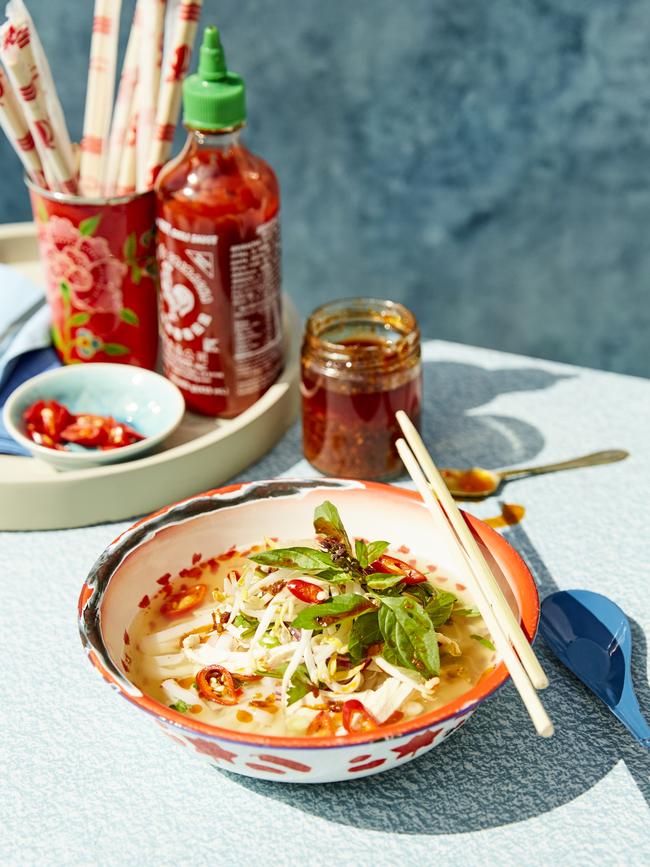
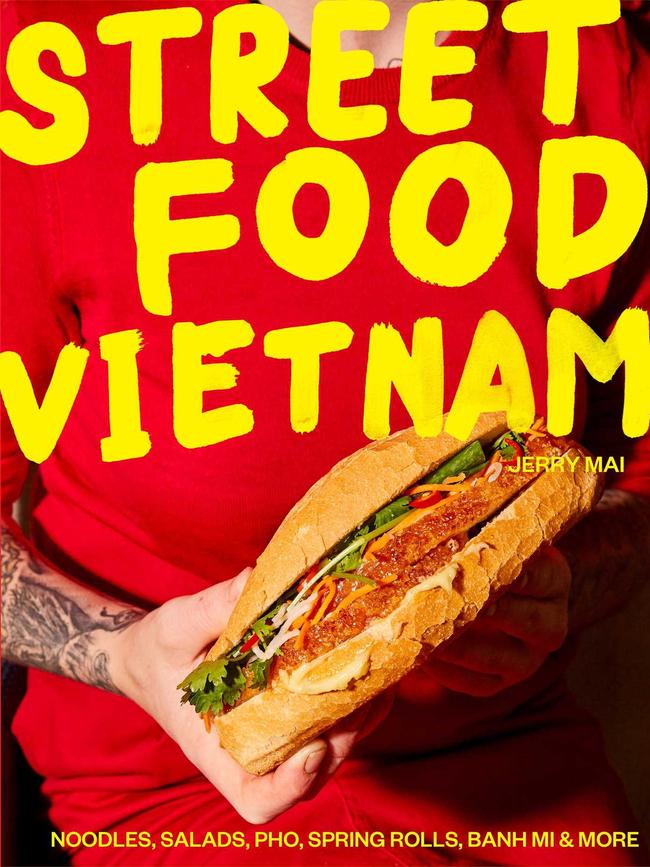
JERRY MAI’S GUIDE TO EATING PHO
One of the best things about pho is that it can be altered to suit your own taste. Love chilli? Go crazy and spice it up. Got a sweet tooth? No problem — add a little hoi sin sauce. Keep these tips in mind when eating your pho, and you’ll be sure to enjoy a bowl that is uniquely yours.
STEP 1 — TASTE THE BROTH
All phos are different, so before you start adding things, taste the broth you’ve got in front of you. Get an understanding of the flavours in your bowl and think about what you want to add to make it perfect.
STEP 2 — SEASON YOUR PHO
So much about pho is getting the balance right. The condiments I like to have available are fresh lemon for sourness, fish sauce for a salty kick, hoi sin sauce to make it sweet and sriracha chilli sauce for spice. Know what you like and go for it, adding a little at a time and tasting as you go to make sure it’s just right.
(Insider tip: I like to make a dipping sauce by mixing lemongrass sate and sriracha chilli sauce, to create my own condiment that is brilliant for dipping proteins into.)
STEP 3 — FRESHEN IT UP!
This step is about the herbs you can add to enhance your pho. All phos need bean sprouts — how many is up to you. Add a small amount of bean sprouts at a time, otherwise they will lower the temperature of the stock. I always add Thai basil and recommend a little fresh chilli to make the soup taste really fresh.
STEP 4 — MIX AND ENJOY!
Use your chopsticks to mix everything together and slurp away!
PHỞ GÁ
Chicken pho — serves 8—10
INGREDIENTS
2kg fresh pho noodles
1 brown onion, thinly sliced
1 bunch spring onions, thinly sliced
1 bunch coriander, leaves picked
Broth
3kg chicken bones
1 old hen or stewing bird
200 g piece of ginger, unpeeled
2 large brown onions, unpeeled
1 garlic bulb, unpeeled, halved
1 × 1kg free-range chicken
6 star anise
2 black cardamom pods
1 small stick cassia bark
50 g coriander seeds
3 tablespoons sea salt
200 ml fish sauce
50 g caster sugar
Accompaniments
1kg bean sprouts
2 bunches Thai basil
6 bird’s eye chillies, sliced
3 lemons, cut into wedges
Sriracha chilli sauce
Hoi sin sauce
Lemongrass sate, fish sauce
METHOD
1. To make the broth, rinse the chicken bones to remove any blood and splinters, then transfer to a 10 litre stockpot. Fill the pot with enough cold water to cover the bones, then place over high heat and bring to the boil. Boil the bones for 20—30 minutes, until no more blood comes to the surface. Drain and discard the cooking liquid, and rinse any remaining blood or impurities from the bones. Return the bones to a clean stockpot and add the old hen (if using). Cover with water to nearly the top of the pot and bring back to the boil.
2. Meanwhile, roast the ginger, onion and garlic over a gas stovetop or barbecue flame, or under the grill (broiler) until the skins are blistered and aromatic. Rinse off any burnt bits and add, whole, to the broth, along with the whole chicken. Poach the chicken for 15—20 minutes until cooked through, then remove from the broth and set aside to cool.
3. Remove the chicken meat from the bones and return the bones to the broth. Tear the chicken meat into smaller pieces and set aside.
4. Toast the star anise, cardamom pods, cassia bark and coriander seeds in a dry frying pan over medium heat until fragrant. Tie the spices in a square of muslin (cheesecloth) and drop it into the broth. Continue to gently simmer the broth over medium heat for a further 4—5 hours until the broth has reduced by 20—30 per cent.
5. When the stock is ready, remove and discard the bones, old hen and spices. Strain the stock through a fine sieve into a clean saucepan. Season the stock with the salt, fish sauce and sugar. Return to a low heat and simmer until ready to serve.
6. Bring a large saucepan of water to the boil. Blanch individual portions of the pho noodles (about 120 g — 150 g per person) for 10 seconds, then transfer to large noodle bowls. Evenly divide the chicken among the bowls, pour over the hot stock and top with the onion, spring onion and coriander.
7. Place the accompaniments on a serving platter and place in the centre of the table. Serve the pho and invite guests to season and flavour their own dish.
PHO BÒ
Beef pho — Serves 8—10
INGREDIENTS
2kg fresh pho noodles (see note)
1kg beef blade steak, very thinly sliced 1 brown onion, thinly sliced
1 bunch spring onions, thinly sliced 1 bunch coriander, leaves picked
Broth
5kg beef marrowbones
200 g piece of ginger, unpeeled 2 large brown onions, unpeeled
1 garlic bulb, unpeeled, halved 1 × 500g beef brisket
1kg oxtail
15 star anise
2 black cardamom pods 2 sticks cassia bark
4 cloves
1 tablespoon coriander seeds 60g sea salt
200 ml fish sauce
50g caster sugar (if needed)
Accompaniments
1kg bean sprouts
2 bunches Thai basil
2 lemons, cut into wedges
6 bird’s eye chillies, sliced
hoi sin sauce
sriracha chilli sauce
fish sauce
METHOD
1. To make the broth, rinse the marrowbones to remove any blood and splinters, then transfer to a 10 litre stockpot. Fill the pot with enough cold water to cover the bones, then place over high heat and bring to the boil. Boil the bones for 20—30 minutes, until no more blood comes to the surface. Drain and discard the cooking liquid, and rinse any remaining blood or impurities from the bones. Return the bones to a clean stockpot, cover with water to nearly the top of the pot and bring back to the boil.
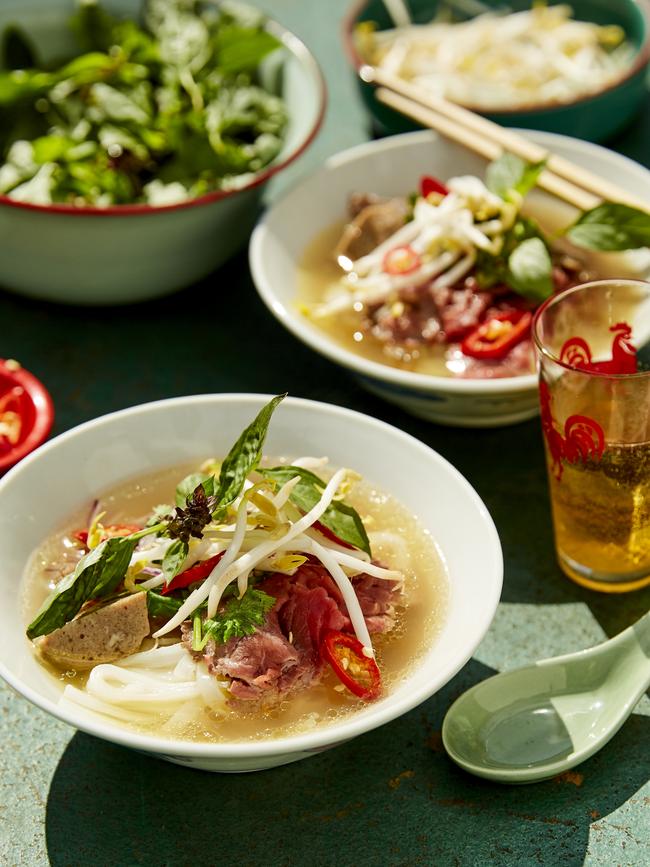
2. Meanwhile, roast the ginger, onion and garlic over a gas stovetop or barbecue flame, or under the grill (broiler) until the skins are charred. Add to the stockpot, along with the brisket and oxtail. Simmer for about 3 hours, removing any impurities as they rise to the surface, or until the meat is tender. Remove the brisket from the broth and set aside to cool, then place in the fridge to use later in the soup. Leave the oxtail in the broth.
3. Bring the stock back to the boil and continue to remove any impurities that rise to the surface.
Simmer gently over medium heat for a further 7—8 hours until the broth has reduced by 20—30 per cent.
4. After 5—6 hours of cooking, lightly toast the star anise, cardamom pods, cassia bark, cloves and coriander seeds in a dry frying pan over medium heat until fragrant. Tie the spices in a square of muslin (cheesecloth) and add to the stockpot for the last few hours of cooking.
5. When the broth is ready, remove and discard the solids. Strain the broth through a fine sieve into a clean saucepan. Season the broth with the salt and fish sauce, and add the sugar if you feel the broth needs a little sweetness. Return to a low heat and simmer until ready to serve.
6. Bring a large saucepan of water to the boil. Using a noodle basket (see note), blanch individual portions of pho noodles (about 120-150g per person) for 10 seconds, then transfer to large noodle bowls.
7. Slice the brisket into 2mm thick slices and evenly divide among the bowls. Top with the thinly sliced beef blade, onion, spring onion and coriander. Ladle the stock into the bowls, ensuring that it’s boiling hot to cook the raw beef slices.
8. Place the accompaniments on a serving platter and place in the centre of the table. Serve the pho and invite guests to season and flavour their own dish.
Notes: Fresh pho noodles can be purchased from most Asian supermarkets. If you are unable to find them, you can also use dried thin rice stick noodles (sometimes referred to as pad thai noodles).
Cook according to the packet instructions, then drain and divide among noodle bowls.
It’s best to use an Asian noodle-blanching basket to cook the noodles. These can be purchased from Asian kitchen supply stores or online.

